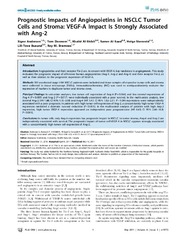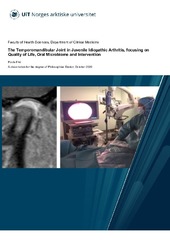Escherichia coli Sequence Type 410 Is Causing New International High-Risk Clones
Permanent lenke
https://hdl.handle.net/10037/14868Dato
2018-07-18Type
Journal articleTidsskriftartikkel
Peer reviewed
Forfatter
Roer, Louise; Overballe-Petersen, Søren; Hansen, Frank; Schønning, Kristian; Wang, Mikala; Røder, Bent L; Hansen, , Dennis S; Justesen, Ulrik S; Andersen, Leif P; Fulgsang-Damgaard, David; Hopkins, Katie L; Woodford, Neil; Falgenhauer, Linda; Chakraborty, Trinad; Samuelsen, Ørjan; Sjöström, Karin; Johannesen, Thor B; Ng, Kim; Nielsen, Jens; Ethelberg, Steen; Stegger, Marc; Hammerum, Anette M.; Hasman, HenrikSammendrag
Escherichia coli sequence type 410 (ST410) has been reported worldwide as an extraintestinal pathogen associated with resistance to fluoroquinolones, third-generation cephalosporins, and carbapenems. In the present study, we investigated national epidemiology of ST410 E. coli isolates from Danish patients. Furthermore, E. coli ST410 was investigated in a global context to provide further insight into the acquisition of the carbapenemase genes blaOXA-181 and blaNDM-5 of this successful lineage. From 127 whole-genome-sequenced isolates, we reconstructed an evolutionary framework of E. coli ST410 which portrays the antimicrobial-resistant clades B2/H24R, B3/H24Rx, and B4/H24RxC. The B2/H24R and B3/H24Rx clades emerged around 1987, concurrently with the C1/H30R and C2/H30Rx clades in E. coli ST131. B3/H24Rx appears to have evolved by the acquisition of the extended-spectrum β-lactamase (ESBL)-encoding gene blaCTX-M-15 and an IncFII plasmid, encoding IncFIA and IncFIB. Around 2003, the carbapenem-resistant clade B4/H24RxC emerged when ST410 acquired an IncX3 plasmid carrying a blaOXA-181 carbapenemase gene. Around 2014, the clade B4/H24RxC acquired a second carbapenemase gene, blaNDM-5, on a conserved IncFII plasmid. From an epidemiological investigation of 49 E. coli ST410 isolates from Danish patients, we identified five possible regional outbreaks, of which one outbreak involved nine patients with blaOXA-181- and blaNDM-5-carrying B4/H24RxC isolates. The accumulated multidrug resistance in E. coli ST410 over the past two decades, together with its proven potential of transmission between patients, poses a high risk in clinical settings, and thus, E. coli ST410 should be considered a lineage with emerging “high-risk” clones, which should be monitored closely in the future. Importance
Extraintestinal pathogenic Escherichia coli (ExPEC) is the main cause of urinary tract infections and septicemia. Significant attention has been given to the ExPEC sequence type ST131, which has been categorized as a “high-risk” clone. High-risk clones are globally distributed clones associated with various antimicrobial resistance determinants, ease of transmission, persistence in hosts, and effective transmission between hosts. The high-risk clones have enhanced pathogenicity and cause severe and/or recurrent infections. We show that clones of the E. coli ST410 lineage persist and/or cause recurrent infections in humans, including bloodstream infections. We found evidence of ST410 being a highly resistant globally distributed lineage, capable of patient-to-patient transmission causing hospital outbreaks. Our analysis suggests that the ST410 lineage should be classified with the potential to cause new high-risk clones. Thus, with the clonal expansion over the past decades and increased antimicrobial resistance to last-resort treatment options, ST410 needs to be monitored prospectively.
Extraintestinal pathogenic Escherichia coli (ExPEC) is the main cause of urinary tract infections and septicemia. Significant attention has been given to the ExPEC sequence type ST131, which has been categorized as a “high-risk” clone. High-risk clones are globally distributed clones associated with various antimicrobial resistance determinants, ease of transmission, persistence in hosts, and effective transmission between hosts. The high-risk clones have enhanced pathogenicity and cause severe and/or recurrent infections. We show that clones of the E. coli ST410 lineage persist and/or cause recurrent infections in humans, including bloodstream infections. We found evidence of ST410 being a highly resistant globally distributed lineage, capable of patient-to-patient transmission causing hospital outbreaks. Our analysis suggests that the ST410 lineage should be classified with the potential to cause new high-risk clones. Thus, with the clonal expansion over the past decades and increased antimicrobial resistance to last-resort treatment options, ST410 needs to be monitored prospectively.
Beskrivelse
Source at https://doi.org/10.1128/mSphere.00337-18.
Forlag
American Society for MicrobiologySitering
Roer, L., Overballe-Petersen, S., Hansen, F., Schønning, K., Wang, M., Røder, B.L., ... Hasman, H. (2018). Escherichia coli Sequence Type 410 Is Causing New International High-Risk Clones. mSphere, 3(4). https://doi.org/10.1128/mSphere.00337-18Metadata
Vis full innførselSamlinger
Relaterte innførsler
Viser innførsler relatert til tittel, forfatter og emneord.
-
Prognostic Impacts of Angiopoietins in NSCLC Tumor Cells and Stroma : VEGF-A Impact Is Strongly Associated with Ang-2
Andersen, Sigve; Dønnem, Tom; Al-Shibli, Khalid Ibrahim; Al-Saad, Samer; Stenvold, Helge; Busund, Lill-Tove; Bremnes, Roy M. (Journal article; Tidsskriftartikkel; Peer reviewed, 2011)Angiopoietins and their receptor Tie-2 are, in concert with VEGF-A, key mediators in angiogenesis. This study evaluates the prognostic impact of all known human angiopoietins (Ang-1, Ang-2 and Ang-4) and their receptor Tie-2, as well as their relation to the prognostic expression of VEGF-A. 335 unselected stage I-IIIA NSCLC-patients were included and tissue samples of respective tumor cells and ... -
The Temporomandibular Joint in Juvenile Idiopathic Arthritis, focusing on Quality of Life, Oral Microbiome and Intervention
Frid, Paula (Doctoral thesis; Doktorgradsavhandling, 2020-10-02)The temporomandibular joint (TMJ) is commonly involved in juvenile idiopathic arthritis (JIA), and may lead to impaired mouth opening, pain and facial growth disturbances. Asymptomatic TMJ arthritis may be diagnosed late in the disease course, thus management is challenging. The overall objectives of this thesis were to provide new knowledge on quality of life (QoL), the oral microbiome and interventions ... -
Humant papillomavirus : en litteraturstudie om HPV, dets relasjon til cancer og tiltak mot videre spredning av virus
Gabrielsen, Endre (Master thesis; Mastergradsoppgave, 2012-06-01)I 1983 oppdaget zur Hausen sammenhengen mellom Humant Papillomavirus (HPV) og livmorhalskreft. På denne tiden visste man ikke at det var HPV som var årsaken til at Helaceller kunne leve in vitro. Ny forskning relaterer HPV til en rekke andre cancertyper. En stor andel anal-, oropharyngeal-, penis-, vaginal-, og vulvacancer skyldes HPV. Det er også påvist HPV i tumorvev fra øsofagus, larynx, lunge, ...


 English
English norsk
norsk


